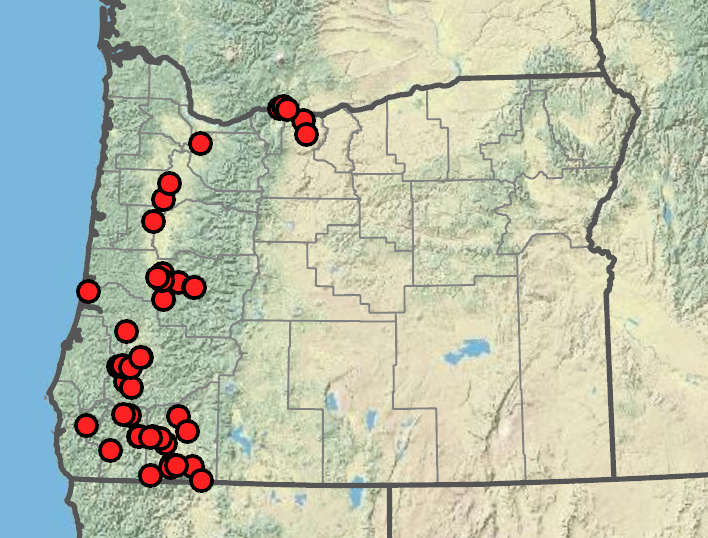Trifolium ciliolatum
Trifolium fragiferum
foothill clover
strawberry clover
palmate;
leaflets 3, elliptic to oblong or obovate, 8–35 × 5–15 mm, bases cuneate;
margins serrate proximally, obscurely denticulate distally;
veins thickened;
tips usually rounded or retuse, rarely acute;
surfaces glabrous;
petioles 10–130 mm;
petiolules ~0.5 mm;
stipules ovate-lanceolate, 10–15 mm;
margins entire, sometimes ciliate;
tips acuminate.
pinnate;
leaflets 3; ovate, obovate, or elliptic, 5–30 × 3–15 mm, bases cuneate;
margins spinulose-denticulate;
veins prominent, thickened, curved;
tips obtuse, often retuse;
surfaces abaxially hairy, adaxially glabrous;
petioles 10–90 mm;
petiolules ~1 mm;
stipules linear or lanceolate, dilated proximally, 13–20 mm;
margins entire;
tips subulate or acuminate.
axillary or terminal, 10–30-flowered; ovoid becoming subglobose, 7–22 × 5–20 mm;
involucres a narrow, membranous, dentate rim; ~0.5 mm;
bracteoles linear or cup-shaped; ? 1 mm.
axillary; erect or ascending, 10–30-flowered, globose, 8–20 × 8–20 mm, distinctly involucrate by bracts of proximal flowers;
involucres cup-shaped;
bracts distinct or connate proximally, lanceolate-oblong, 3–6 mm;
bracteoles linear or lanceolate, 2–3 mm, acuminate or 2-fid.
25–120 mm.
30–170 mm.
erect but becoming reflexed, 0.5–6 mm.
straight; ? 0.5 mm.
6–13 mm;
calyces broadly campanulate, 5–11 mm, glabrous;
veins 10;
tubes 1–5 mm;
lobes elliptic to linear, unequal;
margins hyaline, markedly ciliate, dentate or pectinate; sinuses narrow;
orifices open;
corollas 5–13 mm, white, pink, or purple;
banners broadly ovate, 6–13 × 4–7 mm;
tips rounded, apiculate.
6–8 mm;
calyces tubular, inflated in fruit, markedly asymmetric-bilabiate, 2.5–7 mm, usually pilose to woolly, sometimes glabrescent;
veins 5–10, connected by reticulating lateral veins;
tubes 2–7 mm;
lobes unequal; abaxial straight; ? tube; very unequal in fruit; adaxial spreading in fruit; < tube;
orifices open;
corollas 5–8 mm, white to pink;
banners oblong-lanceolate, 5–8 × 2 mm;
tips emarginate to crenulate.
longitudinally dehiscent; ovoid, 5–10 mm; < 2 × as long as calyces; short-stipitate.
ovoid, 2.5–3 mm; < calyces; long-beaked.
1–2; ovoid, 2.5–3 mm, brown, mottled; smooth.
1–2, globose-reniform, 1–1.4 mm, tan or brown-spotted; smooth; dull.
=16.
=16.
Trifolium ciliolatum
Trifolium fragiferum
Oak-pine chaparral, meadows, roadsides. Flowering May–Jun. 50–800 m. Col, ECas, Sisk, WV. CA, WA; south to Mexico. Native.
Meadows, fields, roadsides, sandy and saline soil. Flowering Jul–Sep. 0–1500 m. BR, Col, ECas, Est, Lava, Owy, Sisk, WV. CA, ID, NV, WA; scattered in North America; Africa, Asia, Europe. Exotic.
Trifolium fragiferum is native to Eurasia. It is cultivated for pastures and in mixtures with grass for hay and silage and to a lesser extent as groundcover in orchards and vineyards and as a green manure cover crop (St. John et al. 2010).
Michael Vincent
Michael Vincent
- Local floras:
BC,
CA,
OR,
WA
- Local Web sites:
CalFlora,
CalPhotos,
Flora NW,
PNW Herbaria
WildflowerSearch
iNaturalist (observations)
USDA Plants Database
- LBJ Wildflower Center
- SEINet
- Plants of the World Online
- Encyclopedia of Life
- Wikipedia
- Google Image Search





